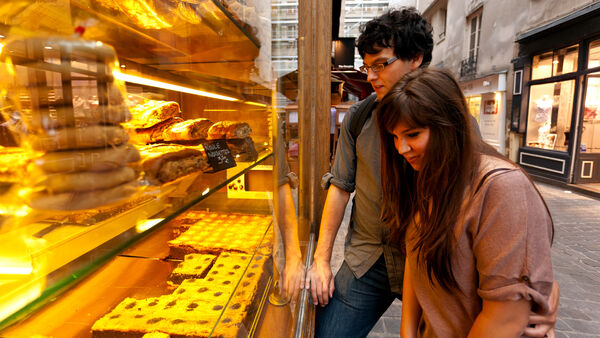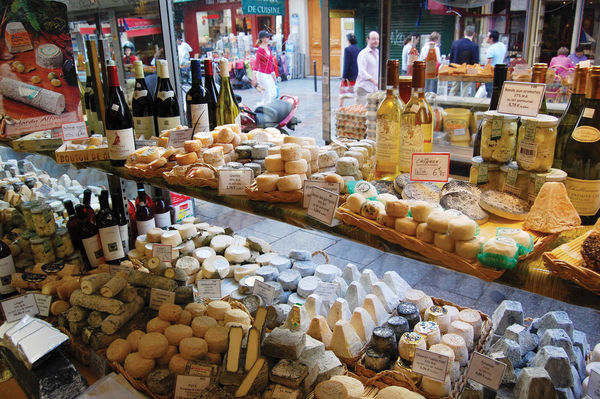Finding Village Charm Along Paris’ Market Streets
Take time out from museum-hopping to experience the cozy, thriving neighborhoods enjoyed by everyday Parisians.
By Rick Steves

As I dodge Parisians walking their poodles and pushing baby strollers down a busy market street, I'm reminded that one of the reasons Paris is endlessly entertaining is its thriving neighborhoods. On streets such as Rue des Martyrs, everyday people make cozy communities in the midst of this vast, high-powered, and touristy city. Along these friendly streets, you find a warm and human vibrancy you'd miss if just hopping from big museum to museum.
While traffic-free Rue Cler, near the Eiffel Tower, is my favorite market street in Paris, Rue des Martyrs, at the base of Montmartre, exudes a younger and trendier, less-touristy market ambience.
Strung across the road above me, a banner announces a neighborhood vide grenier ("empty your attic") sale. At a boulangerie (bakery), a sign in the window brags its baguettes were voted the best in Paris. And next to me, a line of Vespas is poised to deliver sushi for the next online order. (In this affluent neighborhood, delivery services like this are booming.)
Paris is one of the most densely populated cities in Europe, which makes streets like this one particularly lively. Population density is great news for fishmongers, flower merchants, and bakers. In some areas, fishmongers and butchers are being replaced with trendy coffee shops and deli-type restaurants, but a traditional bakery still seems in demand.
Rue des Martyrs leads toward the center of Paris from the busy Boulevard de Clichy. As you wander, you feel the reality of raising a family and a sense of neighborhood in this urban setting. Still, security is a concern. Several side streets are voie privée — private lanes for high-rise, gated communities. Behind big carriage doors, lanes lead to peaceful inner courtyards serving clusters of apartments.
Shopping for groceries is not a mere errand here; it's an integral part of the culture. Parisians shop almost daily for three good reasons: Refrigerators are small (tiny kitchens), produce must be fresh, and it's an important social routine. Shopping is a chance to hear about the butcher's vacation plans, see photos of the florist's new grandchild, relax over un café, and kiss the cheeks of friends. In a Parisian neighborhood like this, people know their merchants as if it were a village.
Goods spill onto the sidewalk. And locals happily pay more at a shop that's not part of a chain. The corner charcuterie still sells various meats. But it's morphed with the times by offering more variety, prepared dishes sold by the weight, and even a few tables so that customers can eat in and linger as well as take out.
Across the street is one of the countless late-night groceries. They are generally run by immigrants who are willing to work the night shift for the convenience of others. And well-to-do locals gladly pay high prices for this convenience. I've been warned that any place advertising prices by the half-kilo is trying to mask a very high markup.
The cheese shop has been serving the neighborhood ever since it used to keep goats and cows out back. This fromagerie preserves its community roots with vintage aluminum milk jugs and old marble shelves stacked high with pungent cheeses. You won't see any mass-market dairy names at this store — it sells only the products of small artisan farms.
About a block away, is the butcher locals head to for top-grade beef. The ceiling hooks — where butchers once hung sides of beef — now display a red medallion that certifies the slaughtered cow's quality. Freshness is expected.
At the pâtisserie, you can jostle with a discerning and salivating clientele for the tasty, delicate, and typically French works of art. They bake up special treats for each season: Easter, Christmas, and so on. I'm here at the end of the school year and it's the season for First Communions — so that's the theme filling the window displays.
And the tabac shop/café on the corner copes with the smoking ban by cramming as many tables as will fit on the sidewalk (where smoking is permitted). Shops like this, once run by rural people from Auvergne, in central France, are now generally run by immigrants. Traditionally the corner café was the community's utility-sales outlet — where you could pay parking tickets, pick up stamps and Métro tickets, and play the lottery. Despite the giant letters reading "fumer tue" (smoking kills), cigarettes sell well. Oh...and there's good coffee, too.
Rue des Martyrs finishes with a commercial climax before ending at the neighborhood church — the Neoclassical (from 1836) Notre Dame de Lorette. And from there, steps lead into the Métro, where all of Paris is a cheap Métro ticket and a few minutes away.

